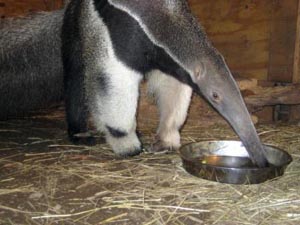| Location: | 1 Franklin Park Road, Boston, MA, 02121 map |
| Phone: | 617-541-5466 |
| Dates: | Saturday, April 2, 2011 - Saturday, April 2, 2011 |
| Hours: | 10 AM - 5 PM weekdays 10 AM - 6 PM weekends |
| Ages: | Infants, Toddlers, Kids, Teens |
| In/Outdoor: | Indoor |
| Cost: | Admission to zoo |
 Zoo New England is pleased to announce that a new giant anteater exhibit will open April 2 inside the Tropical Forest at Franklin Park Zoo.
Zoo New England is pleased to announce that a new giant anteater exhibit will open April 2 inside the Tropical Forest at Franklin Park Zoo.The exhibit will be the new home for Jockamo, a year-old giant anteater. Giant anteaters are the largest known species of anteater, reaching 6-8 feet in length and weighing between 60-140 pounds.
“The giant anteater exhibit is a perfect fit for the Tropical Forest. Visitors will be amazed by this animal’s incredible adaptations and its distinct appearance. We’re thrilled to open this exhibit and educate people about this unique animal,” said John Linehan, Zoo New England President and CEO.
The giant anteater’s long, tube-like head extends up to 18 inches and is truncated by a small mouth. This animal can consume up to 1,000 insects in a few minutes with its sticky 2-foot-long tongue, and up to 30,000 ants and termites in a day.
To highlight the way giant anteaters eat, a special feeding tube, designed to give visitors a rare glimpse at this animal’s exceptionally long, sticky tongue as it rapidly consumes insects, will be presented periodically at the exhibit. While the feeding tube is not a permanent fixture in the exhibit, zookeepers will present it to the anteater during scheduled zookeeper encounters.
Giant anteaters are terrestrial mammals that live in moist tropical forests, dry deciduous forests, as well as swamp, savannah and grassland habitats. Their historic range is from the southern tip of Mexico down to Honduras and south through South America. These striking animals are noted for their distinct coloration and the general coat pattern is predominately brown or grey. Visitors will notice a large black stripe, surrounded by a thin outline of white, beginning beneath the snout and ending about mid-torso. The hair on their long bushy tails can reach up to 40 centimeters in length.
No comments:
Post a Comment